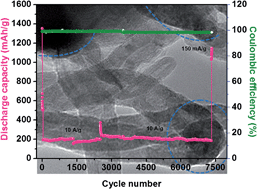Binary reaction ingrained high current density and long cycle life novel anode material for lithium ion battery†
Abstract
The uniqueness in the physical and electrochemical properties and the structural integrity towards lithium ion storage make carbon nanotubes (CNT) a viable anode material for the lithium ion battery. But the morphology dependent electrochemical performance and high irreversibility in capacity stand as stumbling blocks to its commercialization. Herein, we demonstrate that irreversible capacity and short cycle life in CNT based anode material can be eliminated by exfoliation of a few of its outer layers with the incorporation of sulfur. The incorporation of sulfur brings in two lithium ion storage mechanisms in the electrode, insertion and sulfur redox reaction. We have observed this phenomenon by cyclic voltammetry and the corresponding behavioral change by dynamic electrochemical impedance spectroscopy. The assembled battery has been tested for various current densities from 150 to 40 000 mA g−1. The cell retained a capacity of 200 mA h g−1 for 7370 cycles at 10 000 mA g−1, proving the capability of the material for long cycle life even at higher current densities. The ultrahigh capacity of 1120 mA h g−1 at 150 mA g−1 after 10 000 cycles reveals its great potential as an anode material for commercial lithium ion batteries.



 Please wait while we load your content...
Please wait while we load your content...